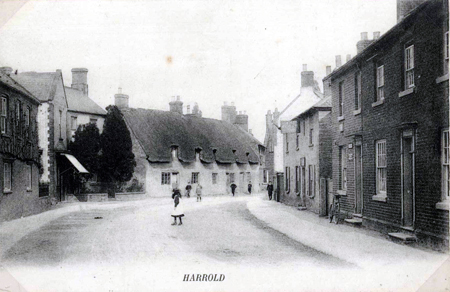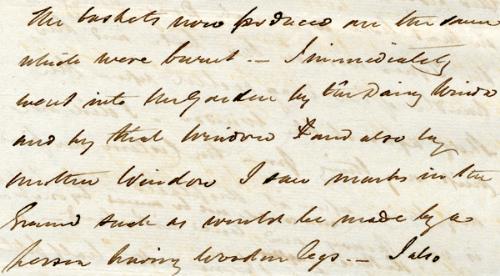Harrold Odell Paths to Crime Walk stop 3 Muntjac
The Muntjac (formerly the Globe), Harrold

Harrold High Street. The Globe is on the right [ref.Z1130/54/23]
A Trail of Footprints
In 1883 Thomas Willey, the landlord of the Globe in Harrold, became involved in a case that is insignificant in itself but illustrates one of the main detection methods available to the Victorian police force – the identification and tracking of footprints. On 2 June 1883 Edward Loakes called at the Globe and offered Willey a garden fork for sale. Willey at first refused to buy it, but when Loakes persisted he lent him two shillings and kept the fork as security. Loakes was to return the following Wednesday but did not do so. It later transpired that the fork had in fact been stolen from David Thompson, a beer seller from Harrold whose other stock for sale included – rather improbably – forks.
The following week a local farmer, John Bailey, missed four pounds of beef and half a pound of butter from his dairy. He searched outside his house and found footprints coming from the direction of Odell. He sent for the local policeman, PC Thomas Page, and together they tracked the footprints across the fields to within fifteen yards of Loakes' back door. PC Page examined Loakes' boots and asked if he had any beef. Loakes admitted he had but claimed his wife had bought it in Harrold and that it had been cooked in a pudding. His wife, however, said that Loakes had got the beef from Harrold. Once in custody the issue of garden forks arose and it became apparent that Loakes had disposed of two stolen forks. Besides the fork stolen from David Thompson he had sold another taken from the barn of William McGrath, a shoemaker at Harrold. Loakes was sentenced to six months imprisonment with hard labour for the theft of the beef and found not guilty of the fork thefts, possibly because there was no direct proof that he himself had taken them although he clearly had them in his possession. At the Quarter Sessions evidence was produced that in 1880 Loakes had been imprisoned for one month at Northampton for stealing a duck, so his track record was against him.
Time and again in the Quarter Sessions records we see footprints used to identify a culprit. Great care was taken to be sure that they were linked to the right person, with detailed descriptions of the imprints left by shoes and boots noting the arrangement of nails in the soles and any other distinguishing marks. An example of the level of detail that could be included can be seen in one of our document of the month pages describing a case in Wymington. In this instance the depositions even included sketch maps of the location of the footprints. Occasionally footprints were so distinctive that there could be no doubt as to who made them. In 1841 Edward Ring, a vagrant, was convicted of a burglary in which he stole three spoons, half a loaf of bread, and a slice of butter from the dairy of a farmer at Oakley. In the morning the farmer's granddaughter saw marks under the dairy window "such as would be made by a person with wooden legs".

The identifying feature recorded for Ring in the gaol register is "lost both legs". He was sentenced to ten years transportation and sent to Van Diemens Land.

One of the witnesses in the case of the stolen beef was the butcher Caleb Le Fevre (pictured above with his family ref.Z50/54/16). He testified that Bailey had bought the meat from him and that he had cut it in a different way to the usual.
References:
QSR1883/3/5/7; QSR1883/3/6/7/a,b,c&d, QSR1841/3/5/36, QGV10/2, Z50/54/16